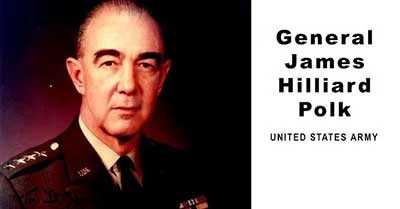James H. Polk: The Batangas-born former US Army Europe Commander-in-Chief
There is this little known fact that one American born in the province of Batangas, and thus by the principle of Jus Soli1 (birthright citizenship) a Batangueño, rose to one of the United States Army’s most prominent positions. That would be the four-star general James Hilliard Polk, born in 1911 at Camp McGrath (a.k.a. Camp McGraw) in what is now Batangas City, admittedly at a time when the entire Philippines was still very much American territory.
His parents were Colonel Harding Polk and the former Esther Fleming2. At the time of his birth, his father was assigned at Camp McGrath, a 175-acre semi-permanent camp of the United States Army named after Hugh H. McGrath in what is now Batangas City.3 The latter was an army captain killed in Noveleta in Cavite in 1899.4
Like his father, the younger Polk would also enroll at West Point and graduate in 1933. He would also emulate his father in gaining a commission at the United States Horse Cavalry. He was a skilled horseman who would win awards at the National Horse Show.
About horses, he would write, “Still your relationship with your horse was highly personal. Together you were a team. So you took good care of your partner.” Inevitably, with the modernization of armies, horse-riding cavalrymen would become an anachronism. About this, he would write, “Frankly, I felt just terrible when the Cavalry was disbanded during early World War II. You couldn’t fight that, of course; it was inevitable. But warfare lost something irreplaceable with the passing of the horse.6”
Polk would see action in World War II as commander of the US Army’s Third Cavalry Group. This was in 1944 when the cavalry had retired its horses in favor of armored vehicles.7 He was serving under the famous World War II General George S. Patton, coincidentally a good friend of his father from the horse-riding cavalry days.
Polk would also see action in the Korean War, until he was recalled stateside to attend the National War College and become one of its instructors. Later, he would become Chief of Staff of the 3rd Armored Division and be promoted to the rank of Brigadier General. He continued to rise up the ladder, all the while becoming an expert in policy planning, even for a time serving at the Department of National Defense.
He was promoted to the rank of Major General in 1963, at the height of the undeclared Cold War of the United States against the Soviet Union. He was stationed at Berlin at the time when the then-East Germany built a wall across the German capital to prevent the exodus of its citizens to parts of the city controlled by the western powers.
 |
| By US Government (Army) - http://www.ebay.co.uk/itm/1969-GENERAL-JAMES-H-POLK-Signed-Photograph-VIETNAM-Saigon-/330869211700, Public Domain, https://commons.wikimedia.org/w/index.php?curid=25557563. |
In 1966, he rose to the rank of Four-Star General, the highest peacetime rank given to an officer of the United States Army.8 He would also be placed in command of the entire US Army in Europe. From his base in Heidelberg in Germany, Polk emphasized training for army personnel in small unit combat tactics. He also worked hard “to halt racial friction and deterioration in troop morale.”
Upon his retirement in 1971, he issued strongly worded statements challenging factions within the United States government intent on reducing the American military presence in Europe at the time. His position was that America must retain a sizable force in the region to prevent the communist bloc from starting a war9.
After finishing his distinguished stint with the military, Polk retired to El Paso in Texas. In his retirement years, he served as Chairman of the Board of the United States Cavalry Association and was also President of the Army Emergency Relief, an organization whose mission it is to provide emergency aid to army soldiers and their dependents.
He passed away in 1992, a decorated soldier who survived the guns and ammunition of the Nazis and the communists but could not ultimately win his own personal war with cancer. His remains are buried at the Arlington National Cemetery, a fitting ending to a great soldier whose eyes first saw light from the skies over Batangas.
2 Along with other information about James Polk, unless otherwise annotated, from “James H. Polk,” Wikipedia.
3 Information about Camp McGrath provided by Dr. Jigger Gilera, M.D.
4 “Hugh J. McGrath,” Wikipedia.
5 “Harding Polk 1910,” online at West Point Association of Graduates.
6 “Charging into History,” by James H. Polk, 1985. Online at People.
7 “3rd Cavalry Regiment (United States),” Wikipedia.
8 “Army Officer Ranks,” online at Military.com.
9 “Gen. James H. Polk, 80, Is Dead; Led U.S. Army in Europe in 60's,” by Eric Page, February 1992. Online at the New York Times.

